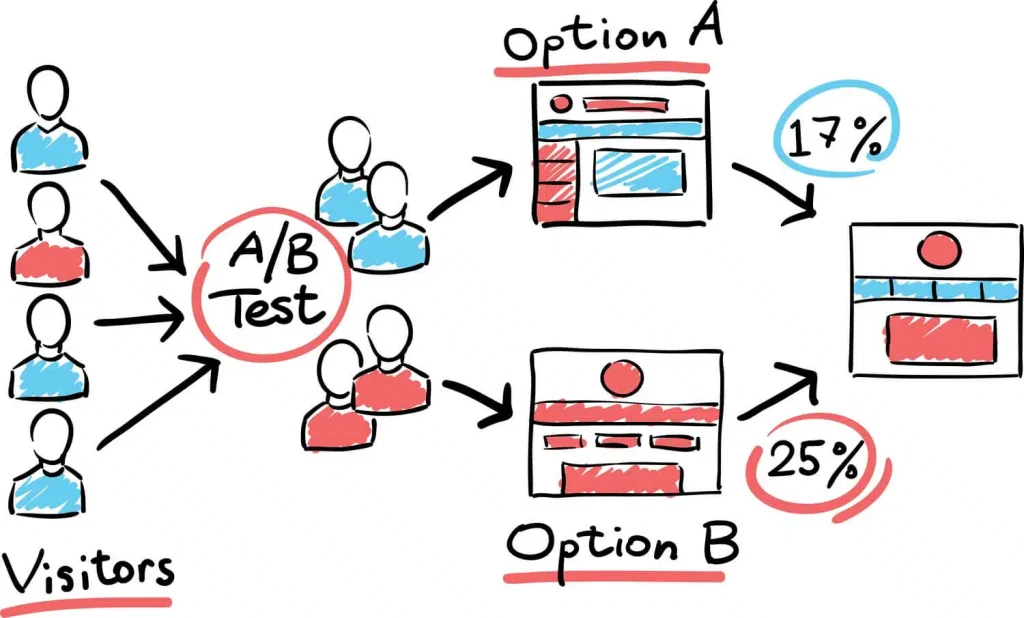No Widget Added
Please add some widget in Offcanvs Sidebar
A/B Testing is a marketing method that consists of creating several versions of the same object in order to determine the most effective version based on a specific objective determined in advance. In the case of the web, this technique allows testing different versions of the same web page on a sample of Internet users (visitors) in order to choose the one that gives the best results. Thus, from an original page, several totally or partially different versions are created. Each group of visitors (A/B) is shown a different version of the page. The statistical analysis of the results via software determines the version producing the best result in relation to the set objective.

A/B Testing is used to achieve various strategic objectives in digital marketing. Its application mainly aims to optimize the user experience on the web by identifying the best performing elements of a page. This can concern the formatting of a call-to-action button, the choice of colors, the placement of navigation elements, or the wording of titles and offers.
The ultimate goal is to increase the effectiveness of a website or mobile app in terms of conversions, whether registrations, sales, or any other action desired by the company. A/B Testing therefore allows decisions to be made based on real data rather than on assumptions, contributing to a more effective and profitable marketing strategy.
One of the main benefits of A/B testing is its ability to provide a solid basis for decision-making. By relying on statistical analysis, marketers can accurately determine which changes generate improved performance and are, therefore, worth implementing. This reduces the guesswork and uncertainty in developing web and marketing strategies.
A/B testing fosters a culture of continuous improvement within marketing and development teams. By regularly testing different aspects of a site or app, businesses can ensure they always provide the best possible experience for their users, while maximizing their conversion potential.
By identifying the best-performing elements of an interface and optimizing them based on audience feedback, A/B Testing can significantly increase the ROI of marketing efforts. Resources are allocated more efficiently, focusing on changes that have proven their value, reducing waste and increasing the profitability of web projects.
A/B testing lends itself to a wide variety of applications, from simple textual modifications to complete layout changes. This flexibility makes it a valuable tool for testing hypotheses in almost every aspect of digital marketing, including SEO, email marketing, and advertising campaigns.
A/B Testing, thanks to its versatility and data-driven approach, finds its use in a multitude of real-world situations within digital marketing. Here are some scenarios where this method proves particularly valuable:
A/B testing is an essential component of any digital marketing strategy aimed at continuous optimization and data-driven decision-making. By allowing companies to test and validate changes before their final implementation, A/B testing helps improve the user experience, increase conversion rates, and ultimately maximize the ROI of digital initiatives. Its approach based on analysis and experimentation ensures that marketing decisions are always guided by tangible data, leading to more effective and profitable strategies.
An A/B test is a type of experiment that compares two different versions of a website, app, or other digital product. In an A/B test, the experimenter runs two versions of the same site or product on the same server.
An AB test is typically conducted by randomly assigning participants into one of the groups and then measuring the outcome for each group. The researcher will then take an average from each group and calculate the difference between them.
A/B testing is an essential part of any digital marketing strategy, especially for companies with multiple products or services with different target audiences. This allows companies to see what types of campaigns are most effective for each type of audience, increasing their conversion rates on one product without affecting another product’s performance.